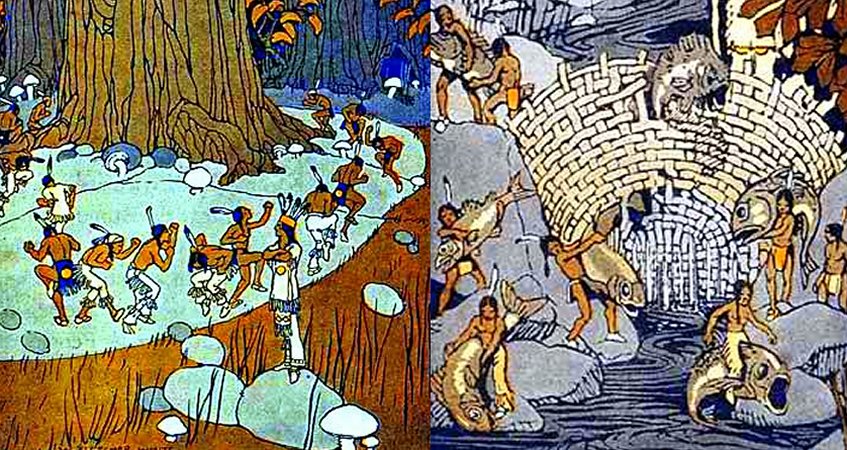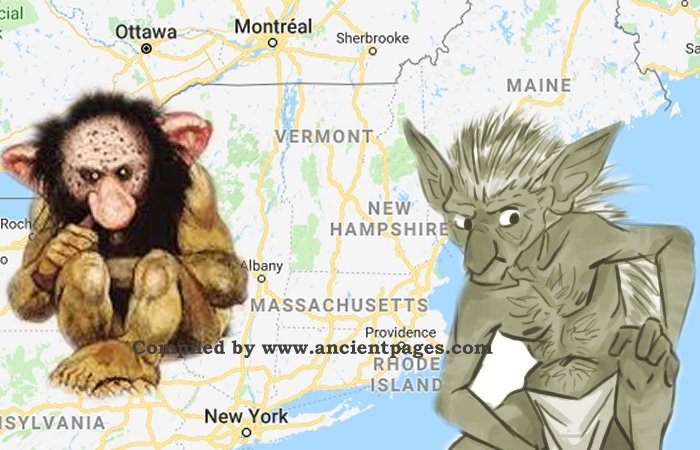Yehasuri – Little People Of South Carolina Living In The Woods – Native Americans’ Version Of Leprechauns
Ellen Lloyd - AncientPages.com - Do you believe a race of little people once walked the Earth? Myths and legends about our ancestors tell about such beings living in woods, mountains, and hidden places where humans couldn’t find them.
Native Americans have a rich oral tradition that tells of a race of tiny people, commonly known as “little people.” The Shoshone Indians of Wyoming tell about the Nimerigar, who were aggressive little people one should definitely avoid due to their hostile nature.
The Catawba Indians in South Carolina have stories about the spirit world that reflects their own native traditions and Christianity. According to the Catawba Indians, the Yehasuri ("wild little people") live in the woods.
Book illustrations of Native American little people. Left: Little people from Stories Iroquois Tell Their Children by Mabel Powers, 1917. Credit: Public Domain - Right: "How Morning Star Lost Her Fish", from Stories the Iroquois Tell Their Children by Mabel Powers, 1917. Credit: Public Domain
The Yehasuri, often called wild little Indians, are about two feet tall and can sometimes be unfriendly. The Catawba believe those little creatures live in tree stumps and eat mostly frogs and insects.
According to Thomas Blumer, the Yehasuri are leprechaun-like creatures. Leprechauns are mainly found in Irish folklore, but ancient accounts of similar beings exist in other parts of the world.
Frank G. Speck visited the Catawba Indians to learn about their language and was told so much about the Yehasuri and their behavior. A woman named Margaret Wiley Brown told Speck that “many wild people live in the woods; they stay in the ground. They cry like children. They eat corns. Tree roots and fungi that grow around trees, the stink turtle, and tadpoles they eat.
Some days they carry off children. If they shoot you, you will die, you cannot know it.”
Margaret Wiley Brown also said that the little wild Indians had once tied a woman to a tree by her hair. It is believed one can stop the Yehasuri by rubbing tobacco on one's hand and recite an ancient Catawba prayer.
According to other stories, the Yehasuri sometimes plaited manes of horses, but why they did this remains a mystery. Blumer writes that “it seems to be significant that only certain horses were affected in such a manner and that no alternate prankster is even suggested.
There are many tricksters in Native American mythology. Another interesting character is the Pukwudgie, a grey-faced humanoid that lives in the forest.
From the tales collected to date, it is impossible to tell why the wild Indians plaited the horses’ hair. Perhaps it was just done to protest the presence of the horse as they invaded the haunts of the wild Indians. This plaiting gesture, which is apparently on the prank level, might have been done to make the Catawbas more aware of the presence of the wild Indians. Apparently, these small beings could be problematic for a mother with small children; they, however, had no real ability to harm a creature as large as a horse.”
Are the Yehasuri real, or do they only live in stories? It is a difficult question to answer and even the Catawba Indians are uncertain.
Some Catawba Indians still believe in the existence of the Yehasuri, while others state these little creatures cannot possibly be real.
Written by Ellen Lloyd – AncientPages.com
Updated on March 31, 2024
Copyright © AncientPages.com All rights reserved. This material may not be published, broadcast, rewritten or redistributed in whole or part without the express written permission of AncientPages.com
Expand for referencesFrank G. Speck – Catawba Texts, New York: Columbia University Press, 1934
Blumer, Thomas J. "Wild Indians, and the Devil: The Contemporary Catawba Indian Spirit World." American Indian Quarterly 9, no. 2 (1985): 149-68. doi:10.2307/1184575.
More From Ancient Pages
-
 Kingdom Of Mitanni: Forgotten For Millennia But Once Great Power Of Ancient West Asia In 2000 BC
Civilizations | Jun 20, 2023
Kingdom Of Mitanni: Forgotten For Millennia But Once Great Power Of Ancient West Asia In 2000 BC
Civilizations | Jun 20, 2023 -
 Chonchon ‘Tue Tue’ Bird With Human Head Brought Bad Omens To Places It Haunted In Beliefs Of Mapuche Indians
Myths & Legends | Mar 12, 2024
Chonchon ‘Tue Tue’ Bird With Human Head Brought Bad Omens To Places It Haunted In Beliefs Of Mapuche Indians
Myths & Legends | Mar 12, 2024 -
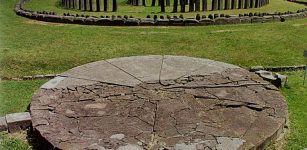 Sarmizegetusa And Its Andesite Sun Artifact Similar To The Mayan Calendar
Artifacts | Apr 13, 2021
Sarmizegetusa And Its Andesite Sun Artifact Similar To The Mayan Calendar
Artifacts | Apr 13, 2021 -
 Rare Gold Foils Found In Ancient Egyptian Tombs At Tel El-Deir In New Damietta
Archaeology | Jul 24, 2024
Rare Gold Foils Found In Ancient Egyptian Tombs At Tel El-Deir In New Damietta
Archaeology | Jul 24, 2024 -
 Viking Cemetery In Lutomiersk And DNA May Solve The Mystery Of Norse Warriors In Central Poland
Vikings | Jan 7, 2025
Viking Cemetery In Lutomiersk And DNA May Solve The Mystery Of Norse Warriors In Central Poland
Vikings | Jan 7, 2025 -
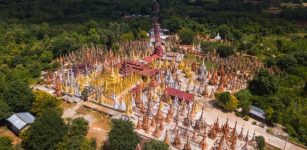 Magnificent Pagodas In Indein Village And Undiscovered Secrets In The Myanmar Jungle
Featured Stories | Oct 9, 2020
Magnificent Pagodas In Indein Village And Undiscovered Secrets In The Myanmar Jungle
Featured Stories | Oct 9, 2020 -
 On This Day In History: Twelfth Council Of Toledo Initiated By King Erwig – On Jan 9, 681
News | Jan 9, 2017
On This Day In History: Twelfth Council Of Toledo Initiated By King Erwig – On Jan 9, 681
News | Jan 9, 2017 -
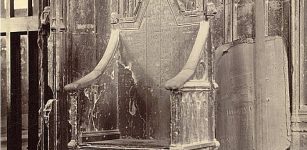 Stone Of Scone: Mysterious Stone Of Destiny Has Turbulent Ancient History
Artifacts | Mar 19, 2016
Stone Of Scone: Mysterious Stone Of Destiny Has Turbulent Ancient History
Artifacts | Mar 19, 2016 -
 Oldest Door Lock Comes From Ancient Egypt
Ancient History Facts | Jun 27, 2018
Oldest Door Lock Comes From Ancient Egypt
Ancient History Facts | Jun 27, 2018 -
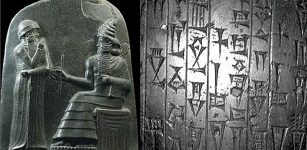 Hammurabi: The Great King Of Babylon And His Laws
Civilizations | Oct 21, 2016
Hammurabi: The Great King Of Babylon And His Laws
Civilizations | Oct 21, 2016 -
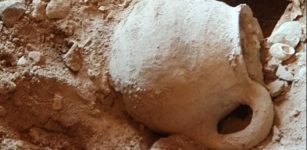 Cave 53 In Qumran Region In Judean Desert Reveals More Secrets
Archaeology | Feb 28, 2022
Cave 53 In Qumran Region In Judean Desert Reveals More Secrets
Archaeology | Feb 28, 2022 -
 The Wild Hunt And The Danger Of Seeing The Phantom Army Of Odin
Featured Stories | Dec 8, 2024
The Wild Hunt And The Danger Of Seeing The Phantom Army Of Odin
Featured Stories | Dec 8, 2024 -
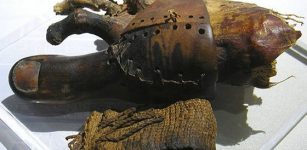 Prehistoric Evidence Of Sophisticated Prosthetics In Ancient Egypt – Artificial Toes Helped Egyptians Walk
Archaeology | Feb 20, 2014
Prehistoric Evidence Of Sophisticated Prosthetics In Ancient Egypt – Artificial Toes Helped Egyptians Walk
Archaeology | Feb 20, 2014 -
 Selene – Greek Goddess Of The Moon And Myth About Love, Jealousy And Punishment
Featured Stories | Jan 24, 2019
Selene – Greek Goddess Of The Moon And Myth About Love, Jealousy And Punishment
Featured Stories | Jan 24, 2019 -
 Wreckage From Famous Warships Explored In 3D On Anniversary Of Sinking
Archaeology | Nov 22, 2022
Wreckage From Famous Warships Explored In 3D On Anniversary Of Sinking
Archaeology | Nov 22, 2022 -
 Unexplained Mysteries Of The Superstition Mountains – A Gateway To Other Worlds?
Featured Stories | Dec 15, 2020
Unexplained Mysteries Of The Superstition Mountains – A Gateway To Other Worlds?
Featured Stories | Dec 15, 2020 -
 Who Was The Sapa Inca?
Featured Stories | Jul 29, 2024
Who Was The Sapa Inca?
Featured Stories | Jul 29, 2024 -
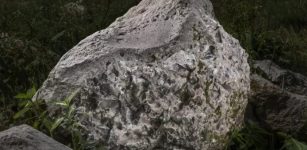 Rare ‘Polishing Boulder’ Used By Stone Age People Found In Dorset, UK
Archaeology | Aug 26, 2023
Rare ‘Polishing Boulder’ Used By Stone Age People Found In Dorset, UK
Archaeology | Aug 26, 2023 -
 Sobek: A 2,500-Year-Old Mummified Nile Crocodile – On Display At The British Museum
Archaeology | Dec 9, 2015
Sobek: A 2,500-Year-Old Mummified Nile Crocodile – On Display At The British Museum
Archaeology | Dec 9, 2015 -
 Ilopango Volcanic Eruption In Maya World 1590 Years Ago – New Study
Archaeology | Oct 2, 2020
Ilopango Volcanic Eruption In Maya World 1590 Years Ago – New Study
Archaeology | Oct 2, 2020

